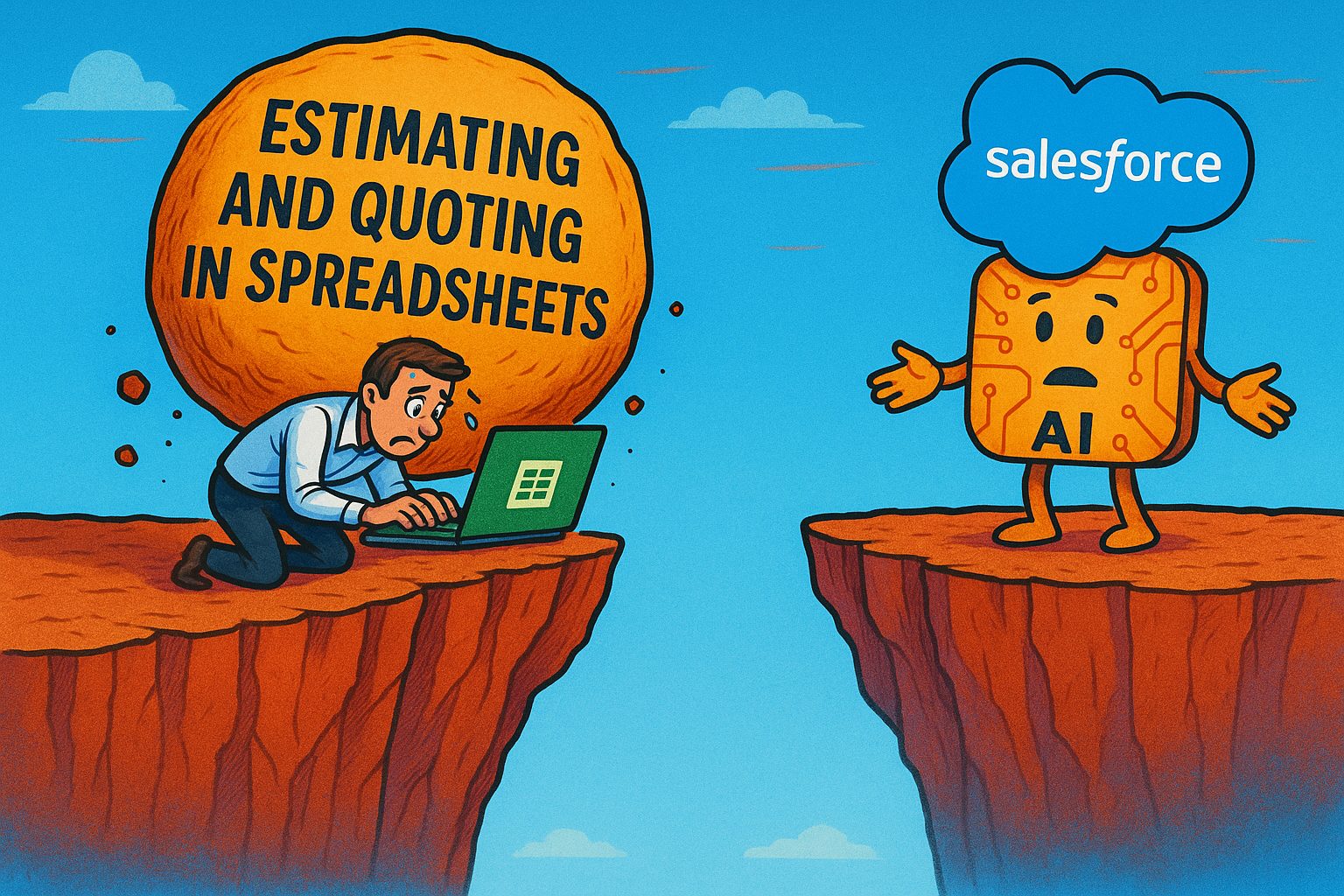
Quoting in Excel? Say Goodbye to AI Ambitions
Overview
In the race toward AI-enabled organizations, quoting is often the blind spot. Everyone wants to talk about predictive forecasting, smart staffing, and margin optimization, but in the meantime, the quoting process lives in a spreadsheet buried in someone’s inbox.
If that’s your starting point, some AI strategies are a non-starter.
In this article, we’ll explore:
- The illusion of control in spreadsheet-based quoting
- Why spreadsheets break forecasting and capacity planning
- How disconnected quoting kills automation and PSA integration
- Why master data matters, and how spreadsheets conflict with this principle
- What’s needed for real AI readiness in services quoting
- How tools like PSQuote solve these problems natively on Salesforce
The Illusion of Control & Collaboration: Why Spreadsheet Quoting Is a Ticking Time Bomb
Spreadsheets feel fast and flexible, but that flexibility hides real cost: from simple human mistakes to the way spreadsheets are designed, understanding these issues is key to reducing risks and finding better ways to quote.
- Human error: Mistakes during data entry, formula creation, or copying and pasting information.
- Complexity: Hidden logic in buried tabs, with a lack of transparency for the end user.
- Scalability: While great for small tasks, spreadsheets struggle with large, shared data. Spreadsheets are not well-suited for managing large and complex data sets or for workflows requiring collaboration and robust data management features.
- Security: Spreadsheets lack the strong data security, role access control, and tracking found in proper quoting tools, making them risky for crucial data.
- Collaboration & Versioning: Working together on spreadsheets can be messy, with version conflicts. It’s tough to know which version is correct (meaning no one knows which file is final).
- Audit Trail: You often can’t tell who changed what, when, or why.
- Approvals: No matter how sophisticated the spreadsheet is, the approval will happen somewhere else, totally disconnected from the source.
Impact on Forecasting and Capacity Planning
Forecasting future work and planning resources against it is crucial for any services organization, yet it is one of the most challenging processes for most. When your service quotes live in an Excel sheet, Delivery managers can’t see what roles are being proposed, when the effort is expected to begin, how many hours are involved, and what margin expectations are assumed in the quote.
This inevitably results in reactive staffing, inflated buffers, or delayed project starts.
A quoting tool like PSQuote fixes this by capturing structured data, roles, dates, effort, and rates inside the opportunity, giving Delivery teams real-time visibility into upcoming demand.
The Spreadsheet-AI Paradox
Here’s the contradiction: many services firms are investing in AI pilots, but they’re still quoting in spreadsheets. While AI can certainly help streamline processes and boost profitability, AI doesn’t work without structured, contextual, readable data. Spreadsheets offer no schema, no metadata, no system context, no real linkage to accounts, products, projects, or historical patterns.
You can’t expect AI to optimize delivery when your quoting process is broken.
PSQuote structures your quoting data natively in Salesforce, turning it into an AI-ready source. This is key: Even for organizations that are not ready to introduce AI in their quoting process, the time to structure the data is NOW. The future AI implementation will be thankful.
No Automation Without Integration: Spreadsheets Block PSA Handoff
Another hidden cost of spreadsheet quoting is the manual handoff into PSA tools (like Kantata, Certinia, etc.).
Here’s what typically happens:
1) The Opportunity is Closed-Won.
2) Someone retypes or copies the effort from the Excel estimator into the PSA tool.
2.1) Wait, no, that was not the final version of the estimator. Let’s start over!
3) Project timelines, roles, and deliverables are approximated. The PM rebuilds the entire Project.
4) You get the point… Automation is impossible when your starting point is a flat file.
With PSQuote, you convert the quote into a project in a single click. No retyping. No delays. Just structured data flowing through your opportunity-to-project lifecycle, natively.
Not only that: During the project delivery, at any time, there is a structured reference to what was sold to compare to what is being delivered.
MDM: Mountains of Data… Managed?
Spreadsheets and MDM (Master Data Management) don’t belong in the same sentence. Oftentimes in organizations that quote services on spreadsheets, each team maintains its copy of rate cards (often outdated or misaligned with finance), service SKUs, project templates, roles, and billing models.
This makes reporting challenging and guarantees inconsistency in pricing, forecasting, and delivery plans.
It is critical to have a clear strategy for master data management. That means: consistent rates, approved SKUs, unified terminology, and traceable discounting and margin models.
Clean master data isn’t just good hygiene: it’s the only way to prepare for scalable quoting and AI-driven delivery optimization.
Conclusion
If you’re still quoting in spreadsheets, you’re already behind. The quoting experience you deliver internally affects your speed, accuracy, and scalability. And the experience you deliver to customers affects your win rate and project success.
You don’t just have a scalability problem: you have a data problem, a collaboration problem, and an AI readiness problem.
PSQuote brings quoting onto the Salesforce platform, where data is connected, structured, and actionable. It eliminates rework, prevents handoff errors, aligns teams, and prepares your organization to actually use AI, not just talk about it.
It’s not just time to upgrade. It’s time to build a quoting process that’s ready for what’s next.
Visualize the Solution
Before You Implement
